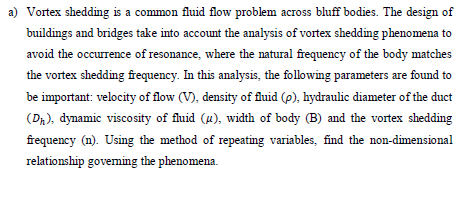Vortex shedding is a common fluid flow problem across bluff bodies. The design of buildings and bridges take into account the analysis of vortex shedding phenomena to avoid the occurrence of resonance, where the natural frequency of the body matches the vortex shedding frequency. In this analysis, the following parameters are found to be important: velocity of flow (V), density of fluid (p), hydraulic diameter of the duct (D₁), dynamic viscosity of fluid (u), width of body (B) and the vortex shedding frequency (n). Using the method of repeating variables, find the non-dimensional relationship governing the phenomena.
Vortex shedding is a common fluid flow problem across bluff bodies. The design of buildings and bridges take into account the analysis of vortex shedding phenomena to avoid the occurrence of resonance, where the natural frequency of the body matches the vortex shedding frequency. In this analysis, the following parameters are found to be important: velocity of flow (V), density of fluid (p), hydraulic diameter of the duct (D₁), dynamic viscosity of fluid (u), width of body (B) and the vortex shedding frequency (n). Using the method of repeating variables, find the non-dimensional relationship governing the phenomena.
Principles of Heat Transfer (Activate Learning with these NEW titles from Engineering!)
8th Edition
ISBN:9781305387102
Author:Kreith, Frank; Manglik, Raj M.
Publisher:Kreith, Frank; Manglik, Raj M.
Chapter5: Analysis Of Convection Heat Transfer
Section: Chapter Questions
Problem 5.13P: 5.13 The torque due to the frictional resistance of the oil film between a rotating shaft and its...
Related questions
Question

Transcribed Image Text:a) Vortex shedding is a common fluid flow problem across bluff bodies. The design of
buildings and bridges take into account the analysis of vortex shedding phenomena to
avoid the occurrence of resonance, where the natural frequency of the body matches
the vortex shedding frequency. In this analysis, the following parameters are found to
be important: velocity of flow (V), density of fluid (p), hydraulic diameter of the duct
(D₁), dynamic viscosity of fluid (u), width of body (B) and the vortex shedding
frequency (n). Using the method of repeating variables, find the non-dimensional
relationship governing the phenomena.
Expert Solution
This question has been solved!
Explore an expertly crafted, step-by-step solution for a thorough understanding of key concepts.
Step by step
Solved in 2 steps with 4 images

Knowledge Booster
Learn more about
Need a deep-dive on the concept behind this application? Look no further. Learn more about this topic, mechanical-engineering and related others by exploring similar questions and additional content below.Recommended textbooks for you

Principles of Heat Transfer (Activate Learning wi…
Mechanical Engineering
ISBN:
9781305387102
Author:
Kreith, Frank; Manglik, Raj M.
Publisher:
Cengage Learning

Principles of Heat Transfer (Activate Learning wi…
Mechanical Engineering
ISBN:
9781305387102
Author:
Kreith, Frank; Manglik, Raj M.
Publisher:
Cengage Learning